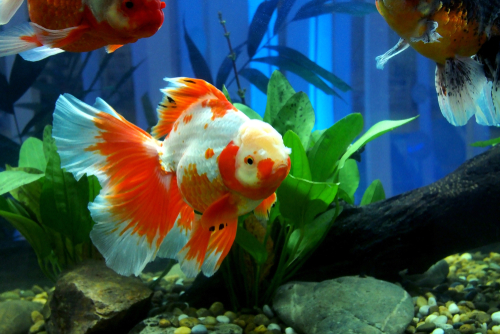Ranchu goldfish are a captivating and unique breed of goldfish that stand out for their distinct appearance and calm demeanor. Hailing from Japan, these captivating creatures have become increasingly popular among aquarists and goldfish enthusiasts around the world.
Known for their curved back, short tail, and lack of dorsal fin, ranchu goldfish are often referred to as the “king of goldfish” because of their prestigious status among goldfish breeds.
Their history goes back several centuries and is rooted in traditional Japanese culture, where they were selectively bred for their ornamental beauty.
Since then, ranchu goldfish have spread globally, captivating the hearts of hobbyists who appreciate their distinctive aesthetic and charming personalities.
As they thrive in various aquatic environments, ranchu goldfish are suitable for both novice and experienced aquarists who are willing to provide the necessary care and attention for these incredible fish.
Contents
Key Takeaways
- Ranchu goldfish are a unique, prestigious breed known for their curved back and lack of dorsal fin.
- They have a rich history in Japanese culture, selectively bred for their ornamental beauty.
- These adorable creatures are well-suited for a range of aquatic environments and skill levels.
Learn more about our other favorite fish types for your aquarium:
Origin and History
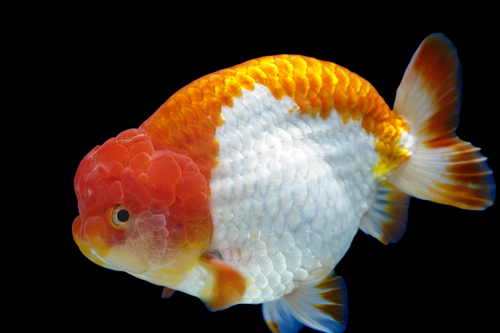
Early Origins
Ranchu goldfish (Carassius auratus), often referred to as the “king of goldfish,” trace their roots back to China. The early ancestors of the ranchu emerged as a result of selective breeding among the common goldfish species.
The distinctive trademark of the ranchu is its round body and the lionhead-like growth, called oyas, on its head. The breeding of goldfish with unique physical features eventually led to the development of the distinctive ranchu variety.
Ranchu in China and Japan
Chinese breeders began by selecting fish with pronounced nuchal humps and lionhead characteristics. Japan then took an interest in the lionhead goldfish and began breeding them in the early 19th century.
They introduced specific breeding guidelines to emphasize the desired traits. Japanese breeders enhanced certain aspects of the lionhead goldfish, such as the back curvature and head growth, to create the modern ranchu we know today.
In both China and Japan, ranchu goldfish are considered a symbol of good fortune and prosperity. Their popularity has only grown over time, with dedicated enthusiasts in both countries continuing to refine and perfect breeding techniques.
Physical Characteristics
Size and Shape
Ranchu goldfish are known for their small size and unique, egg-shaped body. They typically grow to lengths of 6-8 inches (15-20 cm), though some varieties may reach up to 10 inches (25 cm) depending on the environment and genetics.
The body is plump and rounded, often being compared to the shape of a buffalo, giving them a distinctive and charming appearance.
Colors and Varieties
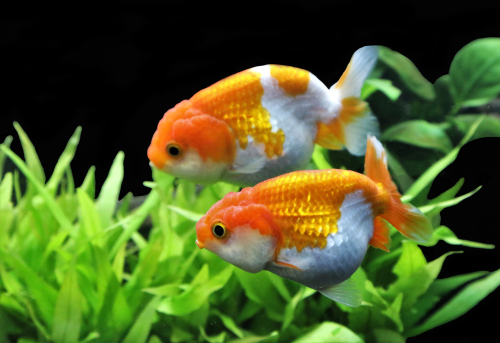
Ranchu goldfish come in a variety of colors and patterns, making them highly diverse and attractive fish for aquarium enthusiasts. Some of the common color combinations include:
- Red and white
- Black and white
- Metallic gold
- Chocolate
While these are some popular examples, Ranchu goldfish are also known to display unique patterns and colorations that cannot be categorized.
Unique Features
One of the most notable characteristics of Ranchu goldfish is the absence of a dorsal fin, which sets them apart from most other goldfish varieties. This unique feature further accentuates their rounded shape and adds to their distinctive appearance.
In addition to the missing dorsal fin, Ranchu goldfish have a beautiful, fan-shaped tail that is heavily branched and forked, creating an elegant and mesmerizing swimming motion. Their large, protruding eyes and charming facial features make these goldfish an attractive choice for aquarium enthusiasts and collectors alike.
Behavior and Temperament
Ranchu goldfish are known for their slow-moving, graceful nature, which adds a sense of tranquility to any aquarium.
These goldfish exhibit peaceful and social behavior, making it easy to integrate them into a community tank with other compatible fish species. Due to their gentle temperament, they are less likely to cause conflicts within the tank.
As curious creatures, ranchu goldfish enjoy exploring their environment, using their senses to seek out interesting flora and fauna within their aquatic home.
Although they are less active than some other goldfish varieties, ranchu goldfish will still benefit from ample swimming space and a stimulating environment.
In terms of social interactions, ranchu goldfish are best kept in small groups, as they enjoy the companionship of their own kind. They can often be seen swimming together, occasionally engaging in playful interactions.
It is worth noting that the size and shape of their bodies can make it challenging for them to compete for food, so owners must take care to ensure that each fish receives an adequate amount of nourishment.
While ranchu goldfish are generally low-maintenance pets, it is essential to monitor their behavior regularly, as sudden changes could be indicative of stress or health issues.
Maintaining a clean, well-maintained tank and providing a balanced diet will go a long way in ensuring the well-being of these charming fish.
Care Requirements

Tank Requirements
Ranchu goldfish require a spacious tank, as they can grow up to 6-8 inches in length. It is recommended that every inch of fish be provided with 10 gallons of water. Thus, a minimum of a 60-gallon tank is ideal.
Ensure a good filtration system is in place to maintain water quality, as they produce a lot of waste. A gentle water flow is preferable, as strong currents can produce stress on the fish.
Include some live plants and hiding spots, but remember to leave enough open space for swimming. Keep the water temperature between 65-75°F and maintain a pH level of 6.5 to 7.5.
Diet and Feeding
Ranchu goldfish are omnivorous and require a well-balanced diet consisting of high-quality pellets, frozen or live foods such as brine shrimp, daphnia, and bloodworms.
Feeding them a mixture of these foods, 2-3 times a day, helps meet their nutritional needs. Be cautious about overfeeding, as it can lead to health issues. Remove uneaten food after a few minutes to avoid polluting the water.
| Food Type | Frequency |
| Pellets | Daily |
| Frozen/live foods | 2-3 times a week |
Health and Common Diseases
Maintaining water quality and a balanced diet can prevent most health problems in ranchu goldfish. However, they are prone to some common diseases, including:
- Swim Bladder Disorder: This can cause the fish to lose buoyancy. Feeding peas can help alleviate the issue.
- Fin Rot: This is a bacterial infection that deteriorates the fins. It can be treated with medications available at pet stores.
- Ich: Small white spots on the body indicate this parasitic infection, treatable with medications.
- Dropsy: Swollen abdomen due to kidney failure. It is challenging to treat, but early detection is crucial.
Regular water changes, adequate filtration, and monitoring the fish’s behavior can prevent these diseases and ensure your ranchu goldfish remains healthy and well-cared for.
Breeding Ranchu Goldfish
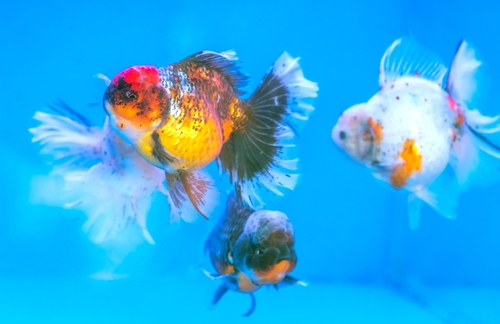
Breeding Ranchu goldfish is an enjoyable and rewarding hobby for many aquarists. It requires some knowledge, dedication, and patience as these ornamental fishes are delicate, but the result of healthy and beautiful offspring makes the effort worthwhile.
To begin the breeding process of Ranchu goldfish, it is essential to select healthy and mature broodstock. Ensure that the parent fish are free of diseases and parasites.
The recommended age for breeding Ranchus is around two years old, and they should exhibit desirable traits to pass on to their offspring.
Environment plays a crucial role in breeding Ranchu goldfish. Set up a separate tank, ideally with a size of 20-30 gallons for the breeding process.
Maintain the water temperature between 68-74°F and provide a clean environment with proper filtration. Adding live plants or spawning mops can help initiate breeding behaviors and protect the eggs once they are laid.
Feeding the breeding pair with a balanced and nutritious diet is key to improve fertility. A combination of high-quality commercial food, frozen, and live foods like brine shrimp, mosquito larvae, and daphnia helps build their nutrients and keep them healthy during breeding.
To trigger spawning in the breeding pair, try gradually increasing the water temperature by 2-4°F over a period of few days. Males will start chasing the females around the tank, a sign that the spawning process is about to begin.
Females can lay up to 1,000 eggs, which typically hatch within 4-7 days. It is important to remove the adult fish from the tank after spawning is complete to prevent them from consuming the eggs or the fry.
Once the fry hatch, they will require special care and nutrition. They need to be fed multiple times a day with small, yet nutritious food such as infusoria, newly hatched brine shrimp, and commercial fry food.
At this stage, consistent monitoring of water quality is mandatory to avoid infections and fatalities among the fry.
In the US, breeding Ranchu goldfish has gained popularity, contributing to the hobbyist community and ensuring the availability of these ornamental fish. Proper breeding and care can result in a thriving population of Ranchu goldfish and encourage the conservation of this fascinating variety.
To guarantee a successful breeding process, remember to select healthy broodstock, prepare a suitable environment, provide a nutritious diet, and maintain optimal water conditions for the offspring.
With commitment and attention to detail, aquarists can experience the joy of raising thriving Ranchu goldfish.
Setting up the Aquarium
Understanding the Right Water Parameters
Ranchu goldfish thrive in stable and clean water conditions. It is essential to monitor the water parameters regularly and adjust them if necessary.
Maintaining an optimal water temperature between 68-74°F (20-23°C) is crucial for their health. Goldfish are cold-water fish, and sudden fluctuations in water temperature can be stressful for them.
Another critical factor is water quality, often measured by pH level and hardness. Ranchu goldfish prefer slightly acidic to neutral water with a pH range of 6.5-7.5.
Water hardness should be between 4-12 dH (degrees hardness). Regular water changes and using a quality filter can help maintain appropriate water parameters.
Choosing Suitable Substrate and Decorations
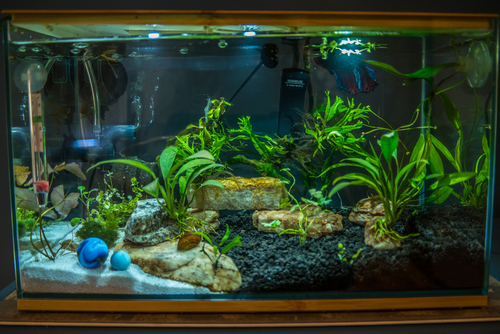
Selecting a suitable substrate is vital for the comfort and well-being of ranchu goldfish. The ideal substrates for these fish are a mix of gravel and sand.
Sand is a natural choice as it allows the goldfish to forage the bottom of the tank comfortably without the risk of injury. On the other hand, gravel provides a stable foundation for plants, decorations, and beneficial bacteria.
When choosing decorations, opt for smooth-edged items like rocks, driftwood, or ceramic ornaments. These can create hiding spots and visual interest, while also being safe for the ranchu goldfish. Additionally, add live or artificial plants to provide cover and improve water quality.
How to Adjust Lighting
Appropriate lighting is essential for the well-being of ranchu goldfish and any live plants in the aquarium. Though ranchu goldfish do not require intense lighting, a proper light cycle helps simulate a natural environment.
A moderate level of light for about 8-10 hours per day is recommended. Utilize an aquarium timer to ensure a consistent light cycle, avoiding fluctuations that can stress the fish.
When choosing a light source, opt for energy-efficient LED fixtures. These offer a wide range of natural tones that can enhance the appearance of ranchu goldfish and their surroundings. Moreover, they generate minimal heat, which helps in maintaining a stable water temperature.
Remember to keep the aquarium away from direct sunlight to prevent excessive algae growth and fluctuations in water temperature.
Ranchu in Goldfish Shows
Ranchu goldfish, often considered the “king” of goldfish, are highly sought after and regularly featured in goldfish shows worldwide.
These elegant and charming fish draw the attention of both hobbyists and professional breeders, with competitions focusing on various aspects of their appearance and overall quality.
In goldfish shows, judges assess the Ranchu in several categories, including body shape, coloration, finnage, and swimming ability.
They look for characteristics such as a compact and deep body, smooth curves, well-balanced fins, and a fat, round, well-proportioned head. The Ranchu’s unique head growth, known as wen, is an essential factor in judging, as it showcases the breed’s distinctiveness.
When it comes to coloration, a Ranchu goldfish can be all red, red-and-white, black, or blue, among other colors. Judges typically evaluate the fish based on the vibrancy, pattern, and consistency of its colors.
In some shows, specific categories may highlight the different color patterns, enabling more opportunities for the Ranchu to showcase their uniqueness.
Alongside body shape and coloration, judges also pay attention to the fish’s overall deportment. A high-quality Ranchu should swim gracefully and effortlessly, despite its compact body and short fins.
A smooth and coordinated swimming style suggests that the fish is in excellent health, which is critical in a competition setting.
Goldfish Variety Comparison

Comparing Ranchu and Lionhead
Ranchu and Lionhead goldfish are both highly sought after for their unique appearances and characteristics. They are often compared due to their similar features, including rounded bodies and distinctive head growths. However, there are key differences between the two.
The Ranchu has a more curved body with a straighter back. Its head growth, or wen, is generally more developed and covers the entire head area. On the other hand, the Lionhead has a higher dorsal area and their wen typically does not cover the full head like the Ranchu.
In terms of care, both varieties require the same level of special attention. They are prone to health issues related to their wen, which could obstruct their vision, and they may have difficulty swimming due to their rounded bodies.
Comparing Ranchu and Oranda Goldfish
The Oranda goldfish (Carassius gibelio forma auratus) shares its Chinese origins with the Ranchu. Although similar in appearance to the goldfish Ranchu, notable differences set them apart. The Ranchu lacks a dorsal fin, a distinctive feature of the Oranda. Additionally, the Ranchu’s head growth is more prominent and fluffy compared to the less pronounced head growth of the Oranda.
Oranda goldfish boast smoother skin and a well-defined back curve, yet are known for their hardiness, surpassing the delicate nature of the Ranchu goldfish. This resilience allows Oranda goldfish to adapt to a broader range of water conditions, essential for goldfish ranchu care.
Comparing Ranchu and Ryukin Goldfish
Ranchu and Ryukin goldfish exhibit similar features, such as egg-shaped bodies, fluffy head protrusions, and double tail fins. However, distinctions exist. Ranchu goldfish are more compact, with a sharply curved body, in contrast to the elongated, less curved form of the Ryukin. The head prominence is also more marked in Ranchu goldfish.
Ryukin goldfish display greater activity and speed when swimming and are generally hardier than Ranchu. Notably, Ryukins exhibit increased aggression during breeding seasons. Careful observation is recommended when keeping Ryukin and Ranchu goldfish together, as the Ryukin’s heightened activity might inadvertently harm the more fragile Ranchu.
Comparing Ranchu and Comet Goldfish
Comet goldfish differ markedly from Ranchu in morphology. While Ranchu goldfish are celebrated as the “king of goldfish” for their ornate appearance, Comet goldfish, resembling the common goldfish, have slimmer bodies, single tail fins, and lack head growths.

Comet goldfish are among the hardiest of the species, easy to care for and quite active. In contrast, Ranchu goldfish are slower, less active swimmers, prone to injury, and have a shorter lifespan. This fragility necessitates specific ranchu care as outlined in the Ranchu goldfish care guide, ensuring these delicate creatures receive the attention they need to thrive in a ranchu fish tank.
Types Of Ranchu Goldfish
Traditional Ranchu Goldfish
Also known as the “Japanese Ranchu,” the traditional ranchu goldfish is a classic representation of this breed. Its well-rounded, egg-shaped body and smooth, hump-like head create an elegant appearance.
This type of ranchu goldfish features a practically non-existent dorsal fin, contributing to its streamlined beauty.
Side-View Ranchu
The Side-View Ranchu offers a striking perspective with its unique side-viewing orientation and egg-shaped body. The prominent hump on its back and gracefully fanned tail fin make this type of ranchu goldfish truly exquisite in appearance.
Its unique orientation adds an intriguing dimension to any aquarium.
Top-View Ranchu
Admired from above, the Top-View Ranchu provides a great view of its captivating features.

With a pronounced head growth and a short, plump body, this type of ranchu goldfish boasts a vibrant and colorful palette. Adding a sense of wonder, Top-View Ranchu goldfish are captivating additions to any aquatic environment.
Calico Ranchu
Featuring vibrant and diverse color patterns, Calico Ranchu goldfish are a delight to behold.
Their alluring appearances usually showcase a wonderful combination of red, orange, black, and white patches. The addition of this type of ranchu goldfish injects bursts of color and personality into any aquarium setting.
Black Ranchu
Highly sought after for their deep, velvety black coloration, Black Ranchu goldfish create a visually stunning effect in any aquarium setting.
Their matte black finish, occasionally accompanied by variations in intensity, provides a stark contrast to other types of ranchu goldfish.
Red-and-White Ranchu
The Red-and-White Ranchu is renowned for its dynamic combination of primary colors – red and white. Their bodies display rich, vibrant red hues along with brilliant white underbellies and fins.
The striking contrast of colors makes this type of ranchu goldfish a favorite among Ranchu enthusiasts.
Chocolate Ranchu
Chocolate Ranchu goldfish are unique in their brownish coloration and resemble the richness of milk chocolate. Their distinct appearance sets them apart within the world of Ranchu goldfish varieties.
This type of ranchu goldfish adds an enticing aspect to any aquarium’s aesthetic.
Overview of Other Goldfish Types
There are numerous other goldfish varieties, each with their own attributes and requirements. Some of these types include:
- Common Goldfish: The most widely recognized type, featuring a streamlined body, single tail, and varying colors.
- Comet Goldfish: Similar to the common goldfish, but with a longer, more pointed tail.
- Shubunkin Goldfish: Known for their beautiful calico patterns and single tail, similar to the comet goldfish.
- Oranda Goldfish: Featuring a wen that covers only the top part of their head and web-like double tail fins.
- Ryukin Goldfish: Recognized by their humped backs, deep bodies, and double tail fins. The hump begins immediately behind their head.
- Bubble Eye Goldfish: Characterized by fluid-filled sacs under their eyes, giving them a unique appearance and requiring extra care.

All goldfish varieties have distinct care requirements and temperaments, making it essential for potential owners to research and understand their needs before bringing them into their homes.
Proper care and aquarium setup can lead to a thriving aquatic environment and a healthy life for these fascinating fish.
Frequently Asked Questions
What is the ideal tank size for Ranchu goldfish?
Ranchu goldfish require an appropriate tank size to thrive. It is recommended to have at least 20-30 gallons of water per Ranchu goldfish, providing ample space to swim and preventing issues related to overcrowding.
How can I properly care for Ranchu goldfish?
To properly care for Ranchu goldfish, maintain optimal water quality with regular checks and changes. Ensure a filtration system is in place and keep water temperature between 65-72°F (18-22°C).
Additionally, feed a well-balanced diet consisting of pellets, vegetables, and occasional treats like live foods. Proper care also includes monitoring the fish for any signs of illness, providing prompt treatment if necessary.
What are some suitable tank mates for Ranchu goldfish?
Ranchu goldfish thrive best with other similar breeds, such as Oranda, Lionhead, and Ryukin goldfish. It is essential to consider the size, temperament, and environmental requirements when selecting tank mates.
Avoid pairing with aggressive or faster-swimming species that may cause stress or compete for food.
What is the typical lifespan of Ranchu goldfish?
With proper care, Ranchu goldfish can live up to 10-15 years. However, their lifespan may vary depending on factors such as water quality, diet, and overall health.
Regular maintenance and monitoring are essential for promoting a long, healthy life.
What are the different color variations in Ranchu goldfish?
Color variations in Ranchu goldfish include red, white, black, calico, and combinations of these colors. Patterns can be solid, bicolor, or tricolor.
These goldfish may change color throughout their lives, influenced by genetic factors and environmental conditions.
Where can I purchase Ranchu goldfish?
Ranchu goldfish can be purchased through local pet stores, specialized fish shops, or online vendors. It is essential to ensure the source is reputable and provides healthy, well-cared-for fish.
Ask for information about the fish’s origins and review their living conditions before purchasing.

Ian Sterling, founder of Fishlab.com, began his aquarium journey over 30 years ago, driven by a deep fascination for fish and their diverse personalities. His website, Fishlab.com, is dedicated to making fishkeeping accessible and enjoyable, offering beginner-friendly guidance, expert insights, and a community for aquarists to connect and share experiences.


